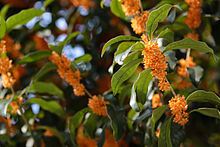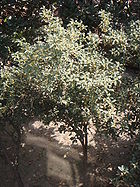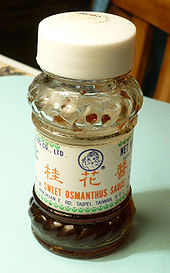- Osmanthus fragrans
-
Osmanthus fragrans 
Scientific classification Kingdom: Plantae (unranked): Angiosperms (unranked): Eudicots (unranked): Asterids Order: Lamiales Family: Oleaceae Genus: Osmanthus Species: O. fragrans Binomial name Osmanthus fragrans
Lour.Osmanthus fragrans (Sweet Osmanthus; Chinese: 桂花 guìhuā; Japanese: 金木犀 kinmokusei; also known as Sweet Olive, Tea Olive and Fragrant Olive) is a species of Osmanthus native to Asia, from the Himalaya east through southern China (Guizhou, Sichuan, Yunnan) and to Taiwan and to southern Japan.[1][2] Sweet osmanthus is also the 'city flower' of Hangzhou, China.
Contents
Growth
It is an evergreen shrub or small tree growing to 3–12 m tall. The leaves are 7–15 cm long and 2.6–5 cm broad, with an entire or finely toothed margin. The flowers are white, pale yellow, yellow, or orange-yellow, small (1 cm long), with a four-lobed corolla 5 mm diameter, and have a strong fragrance; they are produced in small clusters in the late summer and autumn. The fruit is a purple-black drupe 10–15 mm long containing a single hard-shelled seed; it is mature in the spring about six months after flowering.[1][2][3][4]
Cultivation and uses
It is cultivated as an ornamental plant in gardens in Asia, Europe, North America, and elsewhere in the world, for its deliciously fragrant flowers which carry the scent of ripe peaches or apricots.[4] A number of cultivars have been selected for garden use, with varying flower colour.[1][4]
Culinary uses
In Chinese, the plant is called xī (樨) or guìhuā (桂花), and its flowers, called guì huā (桂花, literally "cinnamon flower" or "cassia flower") are used, infused with green or black tea leaves, to create a scented tea called guì huā chá (桂花茶).
In Chinese cuisine, the flowers are also used to produce osmanthus-scented jam (called guì huā jiàng, 桂花醬 or 桂花酱), sweet cakes (called guì huā gāo, 桂花糕), dumplings, soups, and even liquor (called guì huā jiǔ, 桂花酒; or 桂花陈酒, guì huā chén jiǔ).[1] Osmanthus jam is used as an ingredient in a type of gruel called chátāng (茶汤), which is made from sorghum or millet flour and sugar mixed with boiling water. This dish is typical of the northern city of Tianjin, although it may also be found in Beijing.
Traditional uses
The flower herb tea has been used for the treatment of menopathies.[5]
Extracts
The extract of dried flowers showed neuroprotective, free radical scavenging, anti-oxidative effects in in vitro assays.[6]
References
- ^ a b c Flora of China: Osmanthus fragrans
- ^ a b Flora of Pakistan: Osmanthus fragrans
- ^ Mitomori: Osmanthus fragrans (in Japanese; google translation)
- ^ a b c Huxley, A., ed. (1992). New RHS Dictionary of Gardening. Macmillan ISBN 0-333-47494-5.
- ^ Zhou S.,"Flower herbal tea used for treatment of menopathies"., Journal of Traditional Chinese Medicine 2008 28:3 (202-204)
- ^ Lee H.-H., Lin C.-T., Yang L.-L. "Neuroprotection and free radical scavenging effects of Osmanthus fragrans.", Journal of Biomedical Science 2007 14:6 (819-827)
External links
Categories:- Osmanthus
- Flora of Asia
- Medicinal plants
- Plants used in Traditional Chinese medicine
Wikimedia Foundation. 2010.


